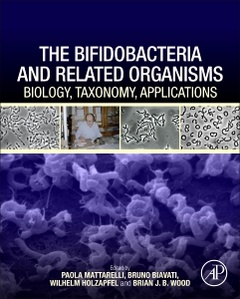The Bifidobacteria and Related Organisms Biology, Taxonomy, Applications
Coordonnateurs : Mattarelli Paola, Biavati Bruno, Holzapfel Wilhelm H., Wood Brian JB

The Bifidobacteria and Related Organisms: Biology, Taxonomy, Applications brings together authoritative reviews on all aspects of Bifidobacteria and related genera. Their place within the Phylum Actinobacteria is discussed first, and this is followed by descriptions of the genera Bifidobacterium, Alloscardovia, Aeriscardovia, Bombiscardovia, Gardnerella, Metascardovia, Parascardovia and Scardovia and the currently accredited species within those genera.
The increased availability of genome sequences and molecular tools for studying bifidobacteria provides important information about their taxonomy, physiology and interactions with their host. Also considerations about common bifidobacterial core maintenance during the mutual coevolution of a host and its intestinal microbes could be relevant for health claims for the ability of symbiotic gut bacteria to provide health benefits to their host, and for evaluating such claims in scientifically valid experiments.
Chemotaxonomy is important to our understanding of these genera and so is considered along with physiological and biochemical aspects before proceeding to examine clinical and other practical aspects. The ability to maintain pure cultures and to grow cells in industrial quantities when required for applications requires that the cells? environmental and nutritional needs are well understood. Some species are important clinically and as animal digestive tract synbionts?and even play a part in honey production?so these matters are considered along with milk oligosaccharides? roles in gut flora development in neonates.
Dr. Bivati is a full professor for Microbiology and Head of Microbiology Area in the Department of Agro-environmental Science and Technologies at Bologna University in Italy. His primary research interests include bifidobacteriaceae, methanoarchea, the microbial ecology of the intestinal tract in humans and farm animals; probiotics, prebiotics and synbiotics; and the antimicrobial activity of natural compounds. Professor Biavati has served on the Editorial Board of Annals of Microbiology since 1995 and is past President of the Italian Society for Agricultural, Food and Environmental Microbiology. He has authored three book chapters and over 75 journal articles.
Wilhelm H. Holzapfel, Chair Professor, Advanced Green Energy and Environment Institute, Handong Global University, Pohang, Gyeongbuk, South Korea. He is the author or co-author of more than 300 scientific papers and over 60 book chapters, and has edited or co-edited 7 books. He has held academic positions (Professor, Honorary Professor and Extraordinary Professor) in microbiology at various universities, and was Head (until 2007) (Director and Professor) of the Institute of Hygiene and Toxicology in Karlsruhe, Germany, and currently is chair professor at Handong Global University, South Korea. Since 1996 he has been President of the ICFMH of the IUMS
Dr Brian J. B. Wood worked first (3 years) at the University of California at Davis, including an Austral Summer in the Antarctic, then for 6 years at Unilever’s Colw
- Presents information on all bacteria in this group in one place
- Provides applications and technological considerations placed alongside more academic matters such as nomenclature and phylogeny
- Includes basic information on the beneficial role of bifidobacteria in the human gut, with particular importance for infants
- Provides information on genomic and gene modification technologies
Date de parution : 09-2017
Ouvrage de 324 p.
21.4x27.6 cm



